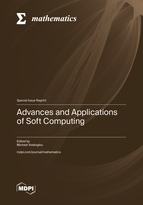Advances and Applications of Soft Computing
A special issue of Mathematics (ISSN 2227-7390). This special issue belongs to the section "D2: Operations Research and Fuzzy Decision Making".
Deadline for manuscript submissions: closed (31 December 2024) | Viewed by 20223
Special Issue Editor
Interests: fuzzy sets and logic; markov chains; abstract and linear algebra; artificial intelligence; mathematics education
Special Issues, Collections and Topics in MDPI journals
Special Issue Information
Dear Colleagues,
In contrast to the conventional methods of hard computing, which are based on symbolic logical reasoning and numerical modeling, soft computing deals with approximate reasoning and processes that provide solutions to complex real-life problems, which cannot be modeled or are too difficult to be modelled mathematically. Soft computing is a synthesis of several computing paradigms that mainly include probabilistic reasoning, fuzzy logic, artificial neural networks, and genetic algorithms. These paradigms are complementary to each other and can be used simultaneously for solving a given problem. Although soft computing only appeared during the 1980s, its techniques are used nowadays successfully in many domestic, commercial, and industrial applications, becoming a major research object in automatic control engineering and having the potential to expand further in the forthcoming era of the Fourth Industrial Revolution and the advanced Internet of things. The target of the present Special Issue of the MDPI journal Mathematics is to provide experts in the field (academics, researchers, practitioners, etc.) with the opportunity to present recent theoretical advances in this field as well as the best practices for a wide range of applications. Papers dealing with case studies and experimental as well as theoretical works, along with their applications to real-life situations, are of particular interest.
Submissions for this Special Issue should address, but are not limited to, the following related topics: probability, Bayesian reasoning, fuzzy sets as well as systems and their extensions/generalizations, fuzzy logic, fuzzy control, fuzzy graphs, intuitionistic fuzzy sets, neutrosophic sets, soft sets, rough sets, grey systems, intelligent systems, artificial neural networks, genetic algorithms, evolutionary computing, Industry 4.0, the Internet of things (IoT), cyber–physical systems, applications of soft computing to education.
Prof. Dr. Michael Voskoglou
Guest Editor
Manuscript Submission Information
Manuscripts should be submitted online at www.mdpi.com by registering and logging in to this website. Once you are registered, click here to go to the submission form. Manuscripts can be submitted until the deadline. All submissions that pass pre-check are peer-reviewed. Accepted papers will be published continuously in the journal (as soon as accepted) and will be listed together on the special issue website. Research articles, review articles as well as short communications are invited. For planned papers, a title and short abstract (about 100 words) can be sent to the Editorial Office for announcement on this website.
Submitted manuscripts should not have been published previously, nor be under consideration for publication elsewhere (except conference proceedings papers). All manuscripts are thoroughly refereed through a single-blind peer-review process. A guide for authors and other relevant information for submission of manuscripts is available on the Instructions for Authors page. Mathematics is an international peer-reviewed open access semimonthly journal published by MDPI.
Please visit the Instructions for Authors page before submitting a manuscript. The Article Processing Charge (APC) for publication in this open access journal is 2600 CHF (Swiss Francs). Submitted papers should be well formatted and use good English. Authors may use MDPI's English editing service prior to publication or during author revisions.
Keywords
- probability
- Bayesian reasoning
- fuzzy sets and systems and their extensions/generalizations
- fuzzy logic
- fuzzy control
- fuzzy graphs
- intuitionistic fuzzy sets
- neutrosophic sets
- soft sets
- rough sets
- grey systems
- artificial intelligence
- intelligent systems
- artificial neural networks
- genetic algorithms
- evolutionary computing
- Industry 4.0
- Internet of Things (IoT)
- cyber-physical systems
- applications of soft computing to education
Benefits of Publishing in a Special Issue
- Ease of navigation: Grouping papers by topic helps scholars navigate broad scope journals more efficiently.
- Greater discoverability: Special Issues support the reach and impact of scientific research. Articles in Special Issues are more discoverable and cited more frequently.
- Expansion of research network: Special Issues facilitate connections among authors, fostering scientific collaborations.
- External promotion: Articles in Special Issues are often promoted through the journal's social media, increasing their visibility.
- Reprint: MDPI Books provides the opportunity to republish successful Special Issues in book format, both online and in print.
Further information on MDPI's Special Issue policies can be found here.






